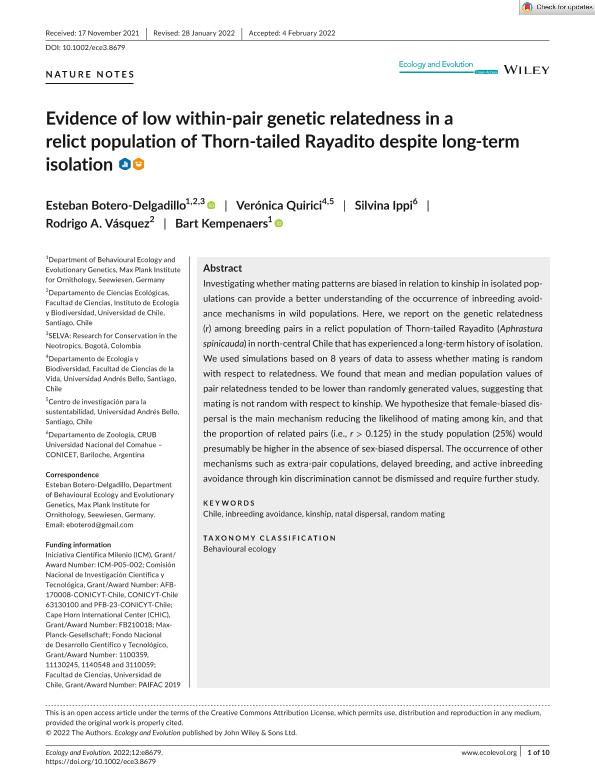Mostrar el registro sencillo del ítem
dc.contributor.author
Botero Delgadillo, Esteban
dc.contributor.author
Quirici, Verónica
dc.contributor.author
Ippi, Silvina Graciela

dc.contributor.author
Vásquez, Rodrigo A.
dc.contributor.author
Kempenaers, Bart
dc.date.available
2023-07-31T14:36:12Z
dc.date.issued
2022-03
dc.identifier.citation
Botero Delgadillo, Esteban; Quirici, Verónica; Ippi, Silvina Graciela; Vásquez, Rodrigo A.; Kempenaers, Bart; Evidence of low within‐pair genetic relatedness in a relict population of Thorn‐tailed Rayadito despite long‐term isolation; Wiley; Ecology and Evolution; 12; 3; 3-2022; 1-10
dc.identifier.issn
2045-7758
dc.identifier.uri
http://hdl.handle.net/11336/206166
dc.description.abstract
Investigating whether mating patterns are biased in relation to kinship in isolated populations can provide a better understanding of the occurrence of inbreeding avoidance mechanisms in wild populations. Here, we report on the genetic relatedness (r) among breeding pairs in a relict population of Thorn-tailed Rayadito (Aphrastura spinicauda) in north-central Chile that has experienced a long-term history of isolation. We used simulations based on 8 years of data to assess whether mating is random with respect to relatedness. We found that mean and median population values of pair relatedness tended to be lower than randomly generated values, suggesting that mating is not random with respect to kinship. We hypothesize that female-biased dispersal is the main mechanism reducing the likelihood of mating among kin, and that the proportion of related pairs (i.e., r > 0.125) in the study population (25%) would presumably be higher in the absence of sex-biased dispersal. The occurrence of other mechanisms such as extra-pair copulations, delayed breeding, and active inbreeding avoidance through kin discrimination cannot be dismissed and require further study.
dc.format
application/pdf
dc.language.iso
eng
dc.publisher
Wiley

dc.rights
info:eu-repo/semantics/openAccess
dc.rights.uri
https://creativecommons.org/licenses/by/2.5/ar/
dc.subject
CHILE
dc.subject
INBREEDING AVOIDANCE
dc.subject
KINSHIP
dc.subject
NATAL DISPERSAL
dc.subject
RANDOM MATING
dc.subject.classification
Zoología, Ornitología, Entomología, Etología

dc.subject.classification
Ciencias Biológicas

dc.subject.classification
CIENCIAS NATURALES Y EXACTAS

dc.title
Evidence of low within‐pair genetic relatedness in a relict population of Thorn‐tailed Rayadito despite long‐term isolation
dc.type
info:eu-repo/semantics/article
dc.type
info:ar-repo/semantics/artículo
dc.type
info:eu-repo/semantics/publishedVersion
dc.date.updated
2023-06-29T10:33:02Z
dc.journal.volume
12
dc.journal.number
3
dc.journal.pagination
1-10
dc.journal.pais
Reino Unido

dc.description.fil
Fil: Botero Delgadillo, Esteban. Universidad de Chile; Chile
dc.description.fil
Fil: Quirici, Verónica. Universidad Andrés Bello; Chile
dc.description.fil
Fil: Ippi, Silvina Graciela. Consejo Nacional de Investigaciones Científicas y Técnicas. Centro Científico Tecnológico Conicet - Patagonia Norte. Instituto de Investigaciones en Biodiversidad y Medioambiente. Universidad Nacional del Comahue. Centro Regional Universidad Bariloche. Instituto de Investigaciones en Biodiversidad y Medioambiente; Argentina
dc.description.fil
Fil: Vásquez, Rodrigo A.. Universidad de Chile; Chile
dc.description.fil
Fil: Kempenaers, Bart. Max Plank Institute For Ornithology; Alemania
dc.journal.title
Ecology and Evolution
dc.relation.alternativeid
info:eu-repo/semantics/altIdentifier/doi/http://dx.doi.org/10.1002/ece3.8679
dc.relation.alternativeid
info:eu-repo/semantics/altIdentifier/url/https://onlinelibrary.wiley.com/doi/10.1002/ece3.8679
Archivos asociados
